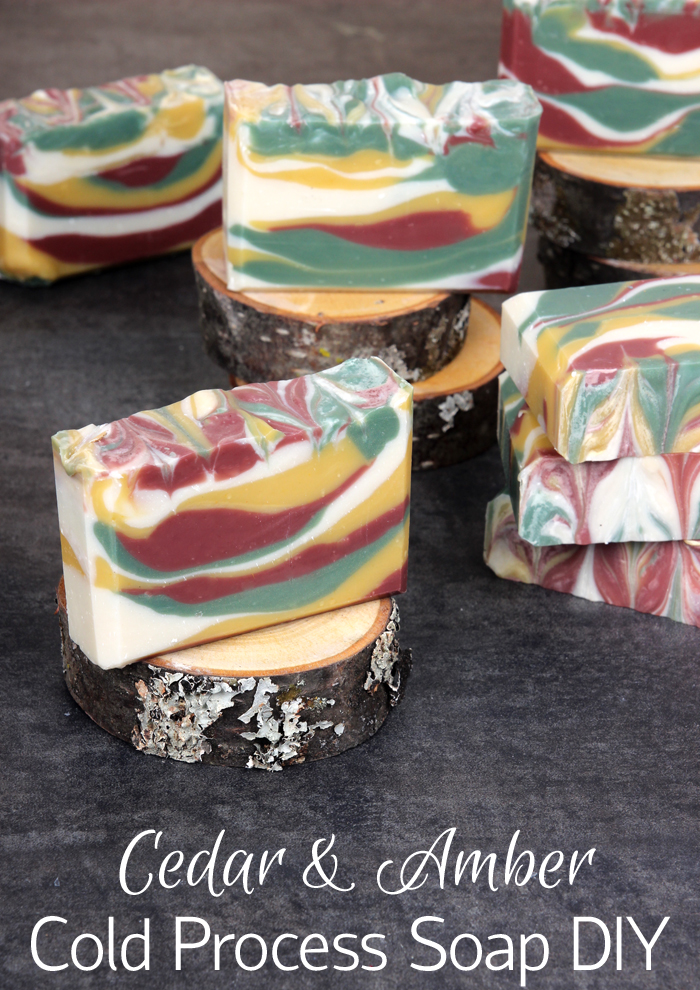
Washington state is known as “The Evergreen State” for the abundance of trees in the area. They have a fresh scent and vivid green color throughout the year. These Cedar & Amber Cold Process Soaps were inspired by the evergreen scenery of the Pacific Northwest. Classic fall colors are layered upon each other using the “spoon-plop” technique. The spoon plop technique is perfect for beginners. All you have to do is spoon in random colors of soap. It creates a unique look in every bar.
The new Cedar and Amber Fragrance Oil gives these bars an earthy, rustic scent. It’s a great unisex fragrance oil with notes of pine, cedar, clove and amber. It’s the perfect complement to the earthy colors in this bar. The soap feels great as well, thanks to moisturizing oils like meadowfoam, olive and sweet almond.
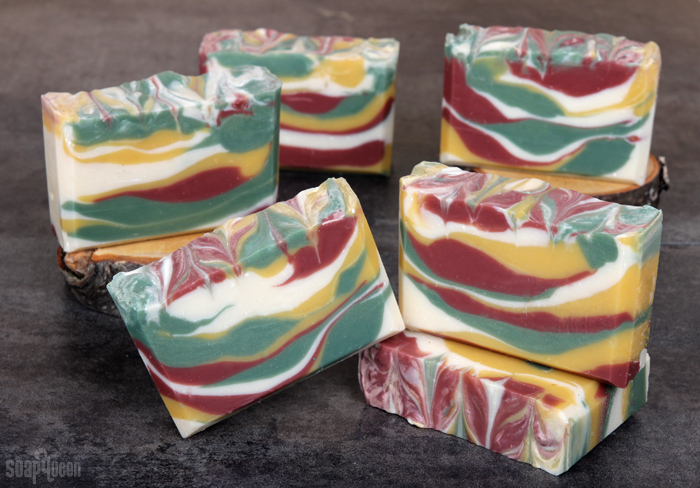
What You’ll Need:
10″ Silicone Loaf Mold
8.8 oz. Coconut Oil (25%)
8.8 oz. Palm Oil (25%)
8.8 oz. Olive Oil (25%)
3.5 oz. Meadowfoam Oil (10%)
3.5 oz. Sweet Almond Oil (10%)
1.8 oz. Castor Oil (5%)
11.5 oz. Distilled Water
4.8 oz. Sodium Hydroxide Lye
2 oz. Cedar and Amber Fragrance Oil
Yellow Oxide
Evergreen Mica
Burgundy Pigment
Titanium Dioxide

Click here to add everything you need for this project to your Bramble Berry shopping cart!
If you’ve never made cold process soap before, stop here! I highly recommend checking out our FREE four part SoapQueen.tv series on Cold Process Soapmaking, especially the episode on lye safety. And if you’d rather do some reading, Bramble Berry carries a wide range of books on the topic, including my newest book, Pure Soapmaking. You can also checkout the digital downloads for that instant gratification factor.
SAFETY FIRST: Suit up for safe handling practices! That means goggles, gloves and long sleeves. Make sure kids, pets, and other distractions and tripping hazards are out of the house or don’t have access to your soaping space. Always soap in a well-ventilated area.
COLOR PREP: To ensure that the Titanium Dioxide blends smoothly into the soap batter, we recommend micronizing it before dispersing it in oil. Please note this is an optional tip but it does help with the titanium dioxide clumping in the soap. =) To micronize colorant, simply use a coffee grinder to blend the colorant to break up any clumps of color and prevent streaks of white from showing in the final soap. We like to use a coffee grinder that has a removable, stainless steel mixing area for easy cleaning. Disperse 1 teaspoon of the colorant into 1 tablespoon of sunflower or sweet almond oil (or any other liquid oil). Then in a separate containers, disperse 1/2 teaspoon Yellow Oxide and Burgundy Pigment into 1/2 tablespoon of oil. Disperse 1 teaspoon of Evergreen Mica into 1 tablespoon of oil. Use a mini mixer to help get rid of any clumps.
FRAGRANCE OIL PREP: In a glass, fragrance oil safe container, measure 2 ounces of Cedar & Amber Fragrance Oil. Set aside.
ONE: Slowly and carefully add the lye to the water and gently stir until the lye has fully dissolved and the liquid is clear. Set aside to cool.
TWO: Fully melt and combine the coconut oil, olive oil, palm oil, castor oil, sweet almond oil and meadowfoam oil (remember to fully melt then mix your entire container of palm oil before portioning). Once the lye water and the oils have cooled to 130 degrees or below (and are ideally within 10 degrees of each other), add the lye water to the oils and stick blend until thin trace. If you’d like a harder bar of soap that releases faster from the mold, you can add sodium lactate to the cooled lye water. Use 1 teaspoon of sodium lactate per pound of oils in the recipe. For this recipe, you’d add about 2 teaspoons sodium lactate.
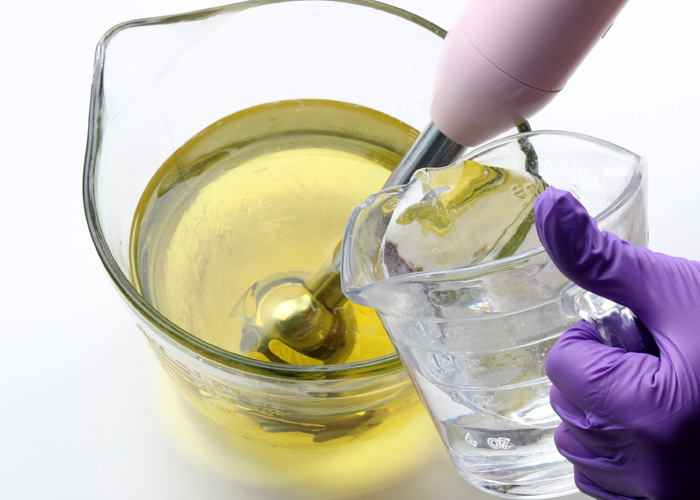
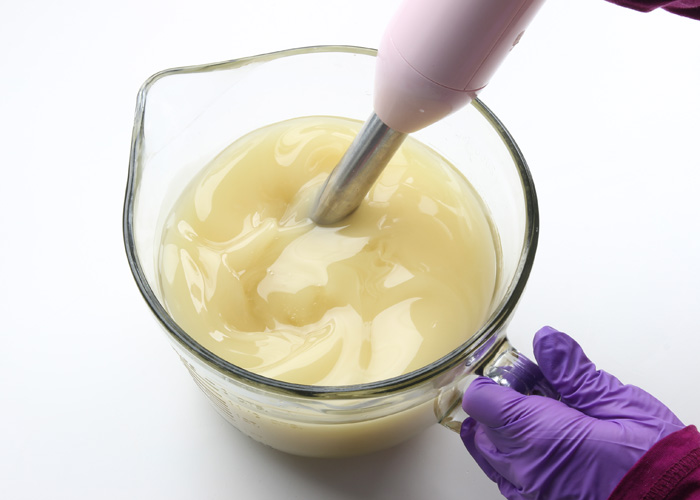 THREE: Once you’ve reached thin trace, split the soap into four even containers. Add the following amounts of dispersed colorants into each container. Use a whisk to fully mix in the colorants.
THREE: Once you’ve reached thin trace, split the soap into four even containers. Add the following amounts of dispersed colorants into each container. Use a whisk to fully mix in the colorants.
- Container A (white): 2 teaspoons dispersed titanium dioxide
- Container B (yellow): 1/4 teaspoon dispersed Yellow Oxide
- Container C (green): All dispersed Evergreen Mica
- Container D (red): 1/4 teaspoon dispersed Burgundy Pigment
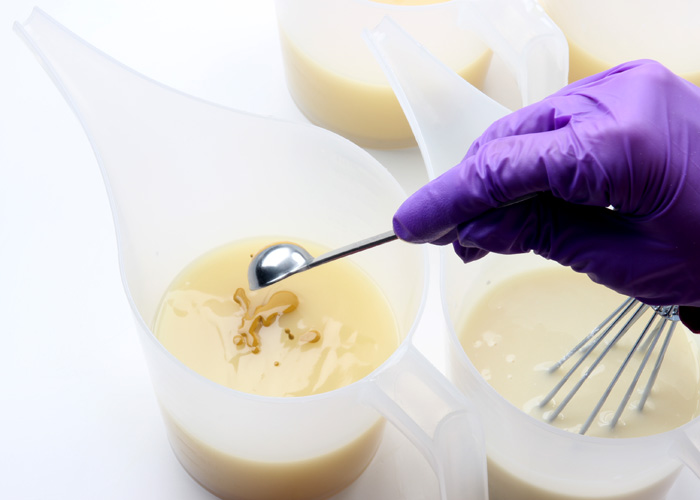
FOUR: Add the measured Cedar & Amber Fragrance Oil evenly into each container. It’s okay to eyeball it! Use a whisk to fully mix in the fragrance oil.
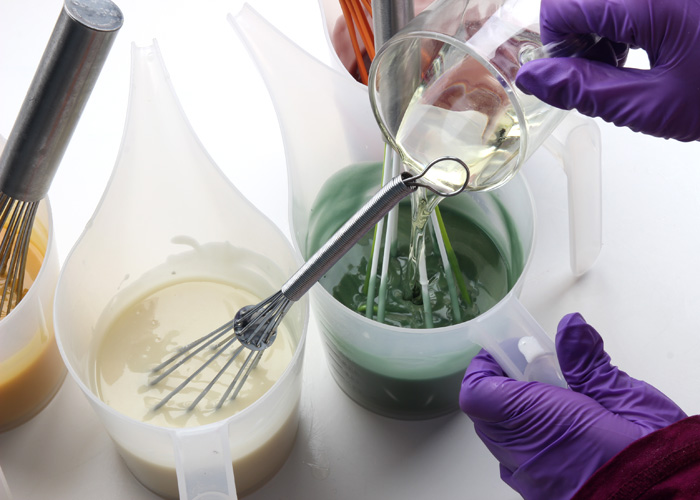
FIVE: If the soap is still a thin trace, use the stick blender and pulse each container to thicken slightly. The spoon-plop technique works best with medium trace soap.
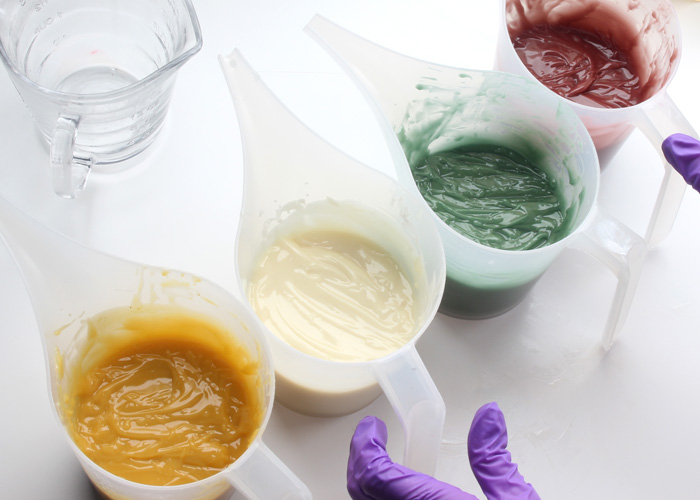
SIX: Grab a large spoon for each color. Spoon the soap into the mold, one color at a time, layering them in three different spots. Don’t worry about being too precise with your “plops.”
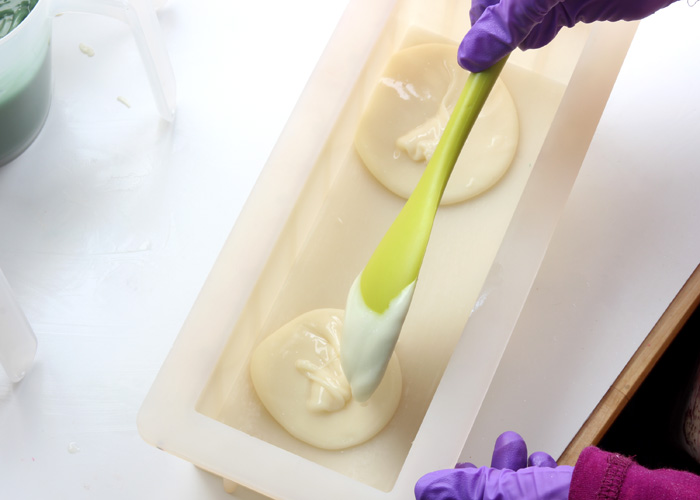
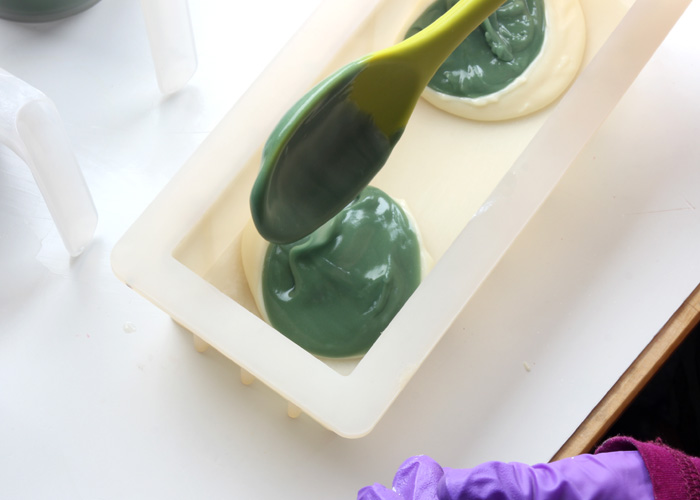
SEVEN: Continue plopping each color into the mold in various areas. You can keep a consistent color pattern or shake it up! For this project, I didn’t keep a consistent pattern. Instead I placed various colors in the mold, being careful to not layer the same color twice. Every now and then, tap the mold firmly on the counter to help level the soap and get rid of bubbles.
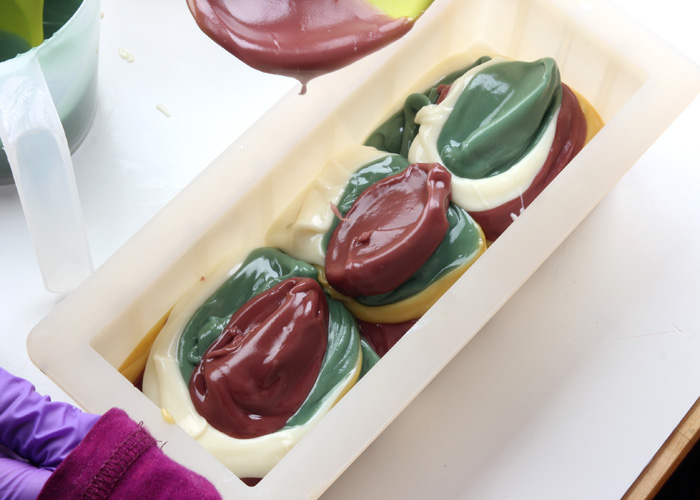
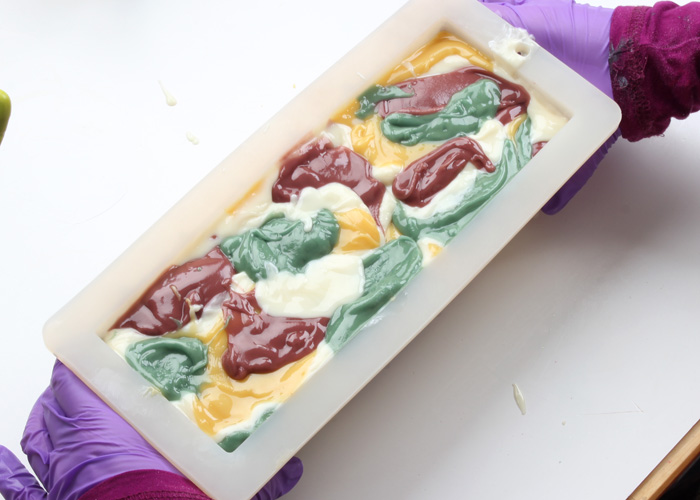
EIGHT: Once all the soap is in the mold, insert a chopstick or dowel into the very top of the soap and create “S” shaped curves down the length of the mold. Then, insert the dowel or chopstick into the very top of the soap again, and create large “S” shaped curves in the opposite direction down the length of the mold.
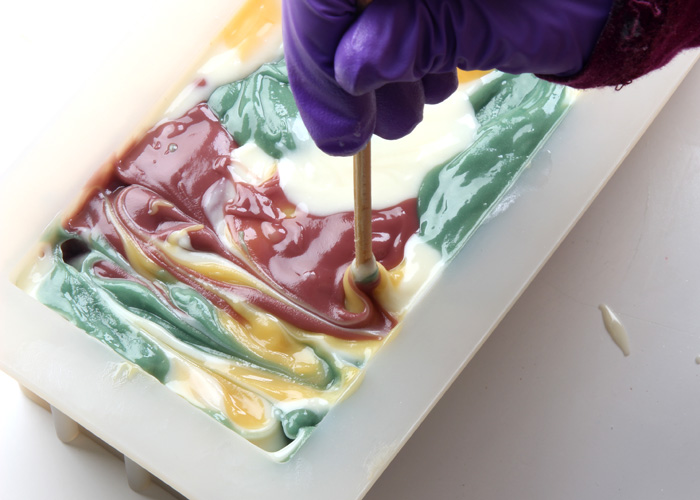
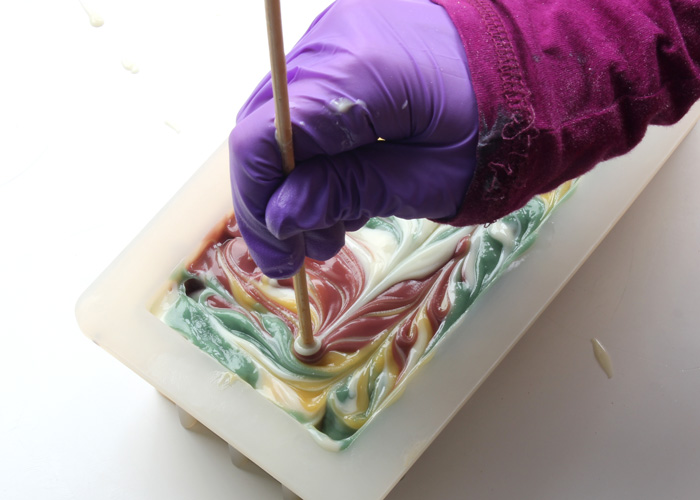
NINE: Spritz the top of the soap with 99% isopropyl alcohol, and cover to insulate for 24 hours. Allow to stay in the mold for 2-3 days. Remove from the mold and cut into bars. Allow the soap to cure for 4-6 weeks. Enjoy!
Even with insulating and spritzing with alcohol, we got some soda ash on this soap. It’s starting to get colder here in Bellingham, so this is something we deal with every year. Learn more about soda ash and how to handle it here.
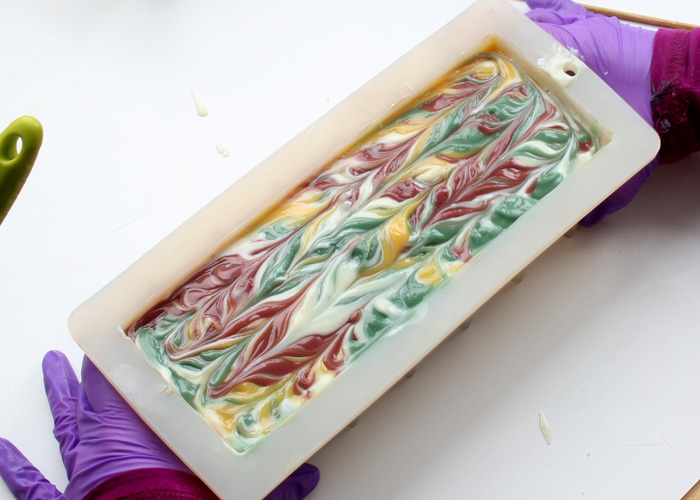
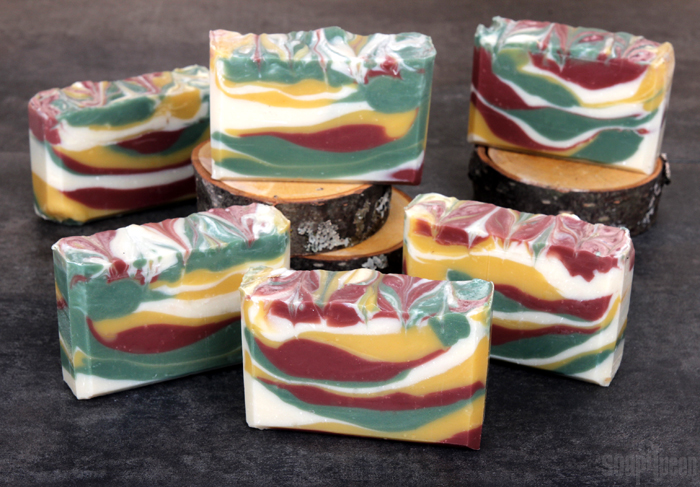
- 10″ Silicone Loaf Mold
- 8.8 oz. Coconut Oil (25%)
- 8.8 oz. Palm Oil (25%)
- 8.8 oz. Olive Oil (25%)
- 3.5 oz. Meadowfoam Oil (10%)
- 3.5 oz. Sweet Almond Oil (10%)
- 1.8 oz. Castor Oil (5%)
- 11.5 oz. Distilled Water
- 4.8 oz. Sodium Hydroxide Lye
- 2 oz. Cedar and Amber Fragrance Oil
- Yellow Oxide
- Evergreen Mica
- Burgundy Pigment
- Titanium Dioxide
- Slowly and carefully add the lye to the water and gently stir until the lye has fully dissolved and the liquid is clear. Set aside to cool.
- Fully melt and combine the coconut oil, olive oil, palm oil, castor oil, sweet almond oil and meadowfoam oil (remember to fully melt then mix your entire container of palm oil before portioning). Once the lye water and the oils have cooled to 130 degrees or below (and are ideally within 10 degrees of each other), add the lye water to the oils and stick blend until thin trace. If you’d like a harder bar of soap that releases faster from the mold, you can add sodium lactate to the cooled lye water. Use 1 teaspoon of sodium lactate per pound of oils in the recipe. For this recipe, you’d add about 2 teaspoons sodium lactate.
- Once you’ve reached thin trace, split the soap into four even containers. Add the following amounts of dispersed colorants into each container. Use a whisk to fully mix in the colorants.
Container A (white): 2 teaspoons dispersed titanium dioxide
Container B (yellow): ¼ teaspoon dispersed Yellow Oxide
Container C (green): All dispersed Evergreen Mica
Container D (red): ¼ teaspoon dispersed Burgundy Pigment - Add the measured Cedar & Amber Fragrance Oil evenly into each container. It’s okay to eyeball it! Use a whisk to fully mix in the fragrance oil.
- If the soap is still a thin trace, use the stick blender and pulse each container to thicken slightly. The spoon-plop technique works best with medium trace soap.
- Grab a large spoon for each color. Spoon the soap into the mold, one color at a time, layering them in three different spots. Don’t worry about being too precise with your “plops.”
- Continue plopping each color into the mold in various areas. You can keep a consistent color pattern or shake it up! For this project, I didn’t keep a consistent pattern and instead just placed various colors in the mold, being careful to not layer the same color twice. Every now and then, tap the mold firmly on the counter to help level the soap and get rid of bubbles.
- Once all the soap is in the mold, insert a chopstick or dowel into the very top of the soap, and create “S” shaped curves down the length of the mold. Then, insert the dowel or chopstick into the very top of the soap again, and create large “S” shaped curves in the opposite direction down the length of the mold.
- Spritz the top of the soap with 99% isopropyl alcohol, and cover to insulate for 24 hours. Allow to stay in the mold for 2-3 days. Remove from the mold and cut into bars. Allow the soap to cure for 4-6 weeks. Enjoy!
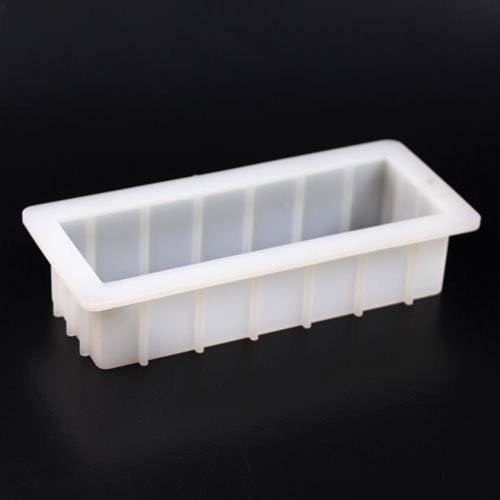
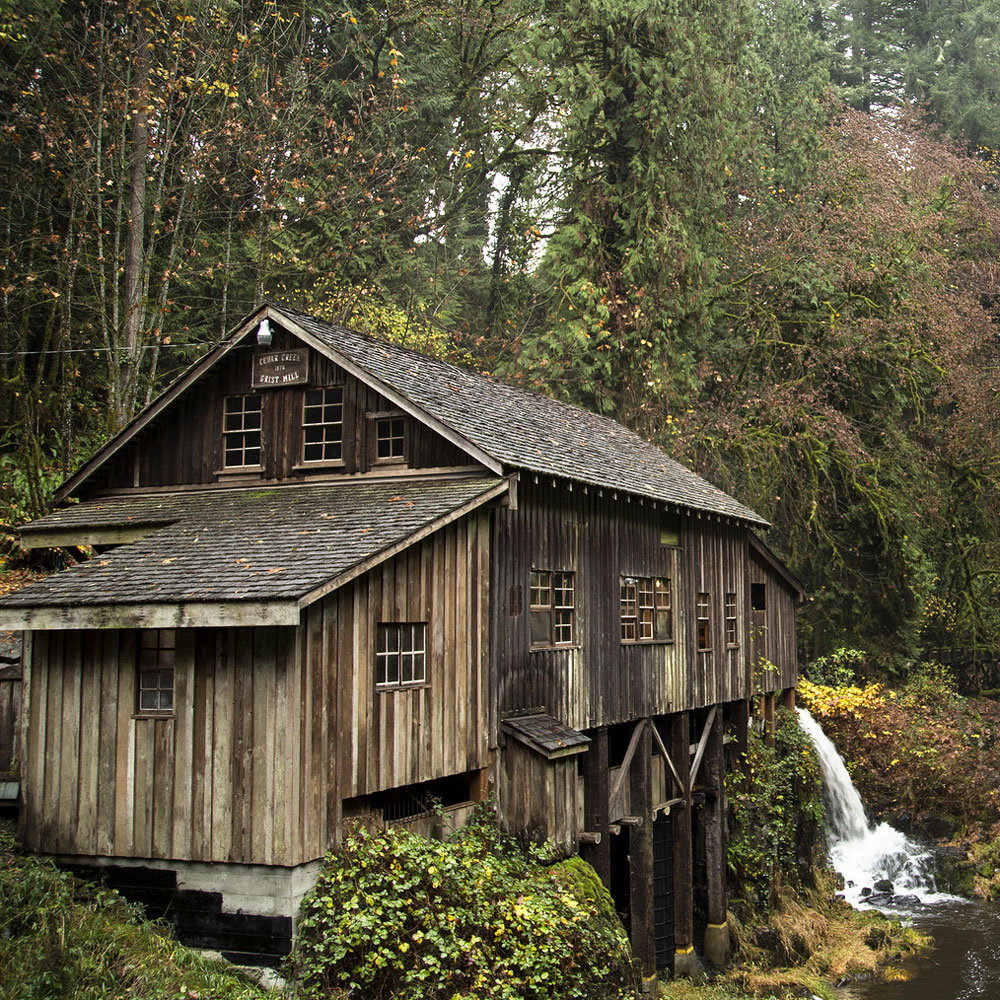
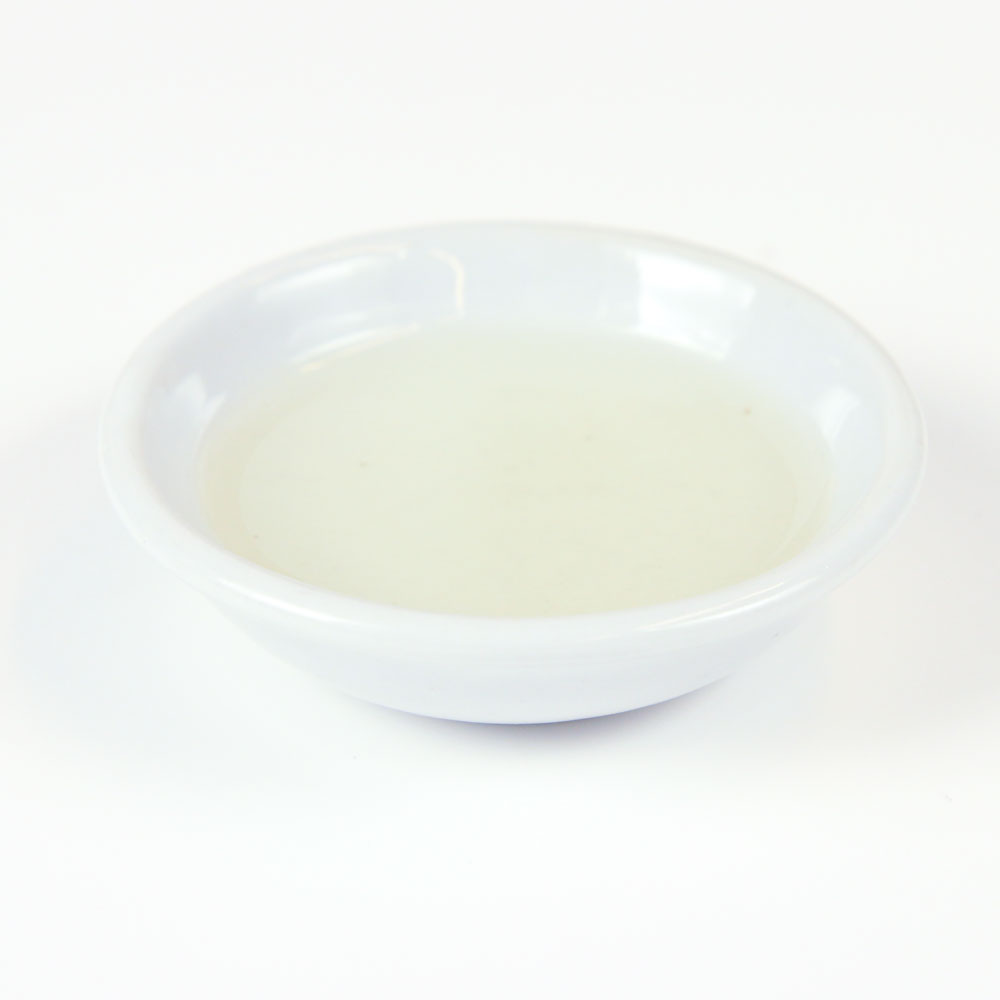
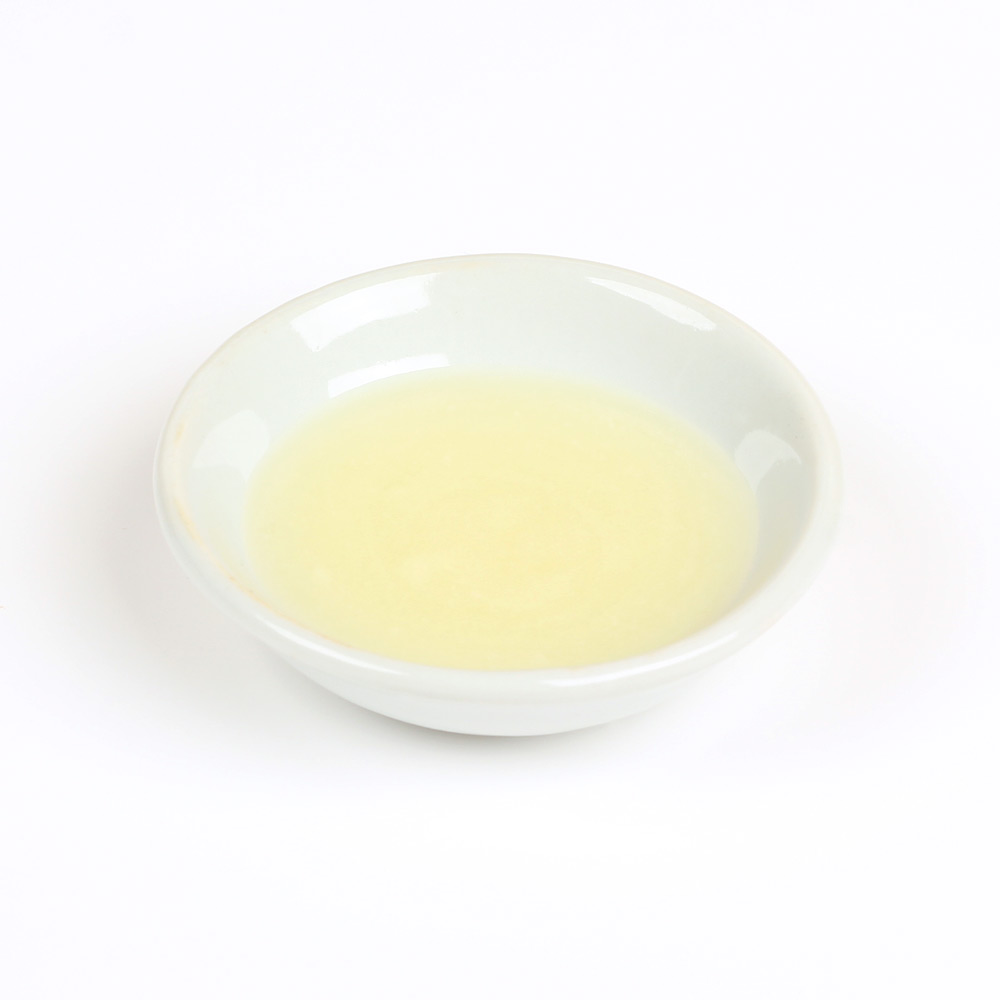
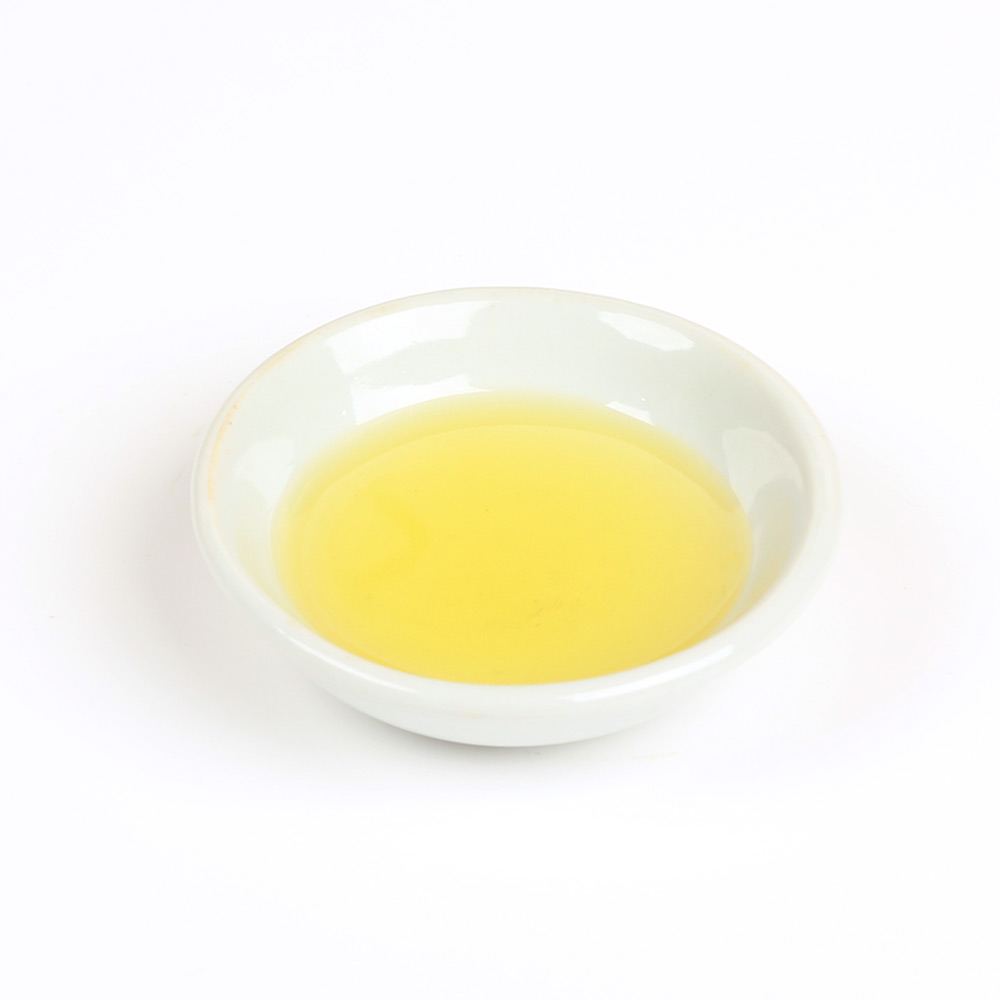
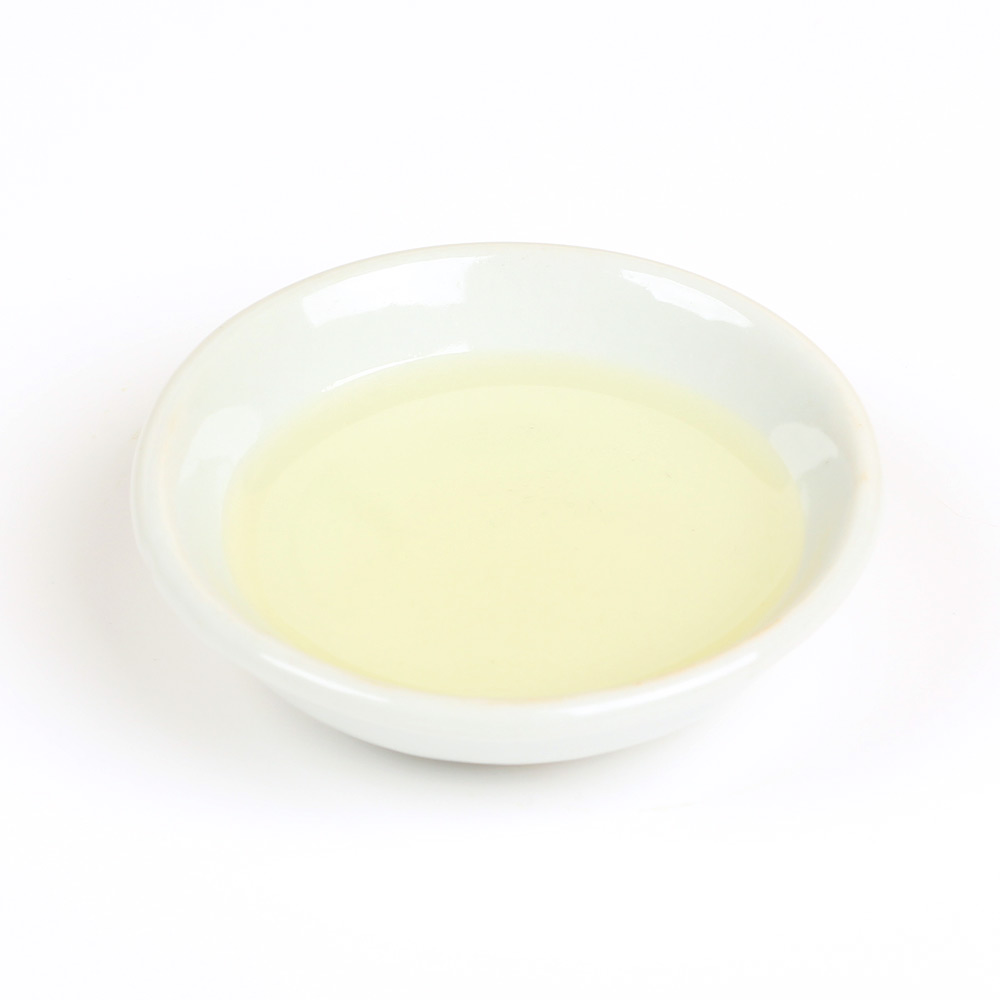

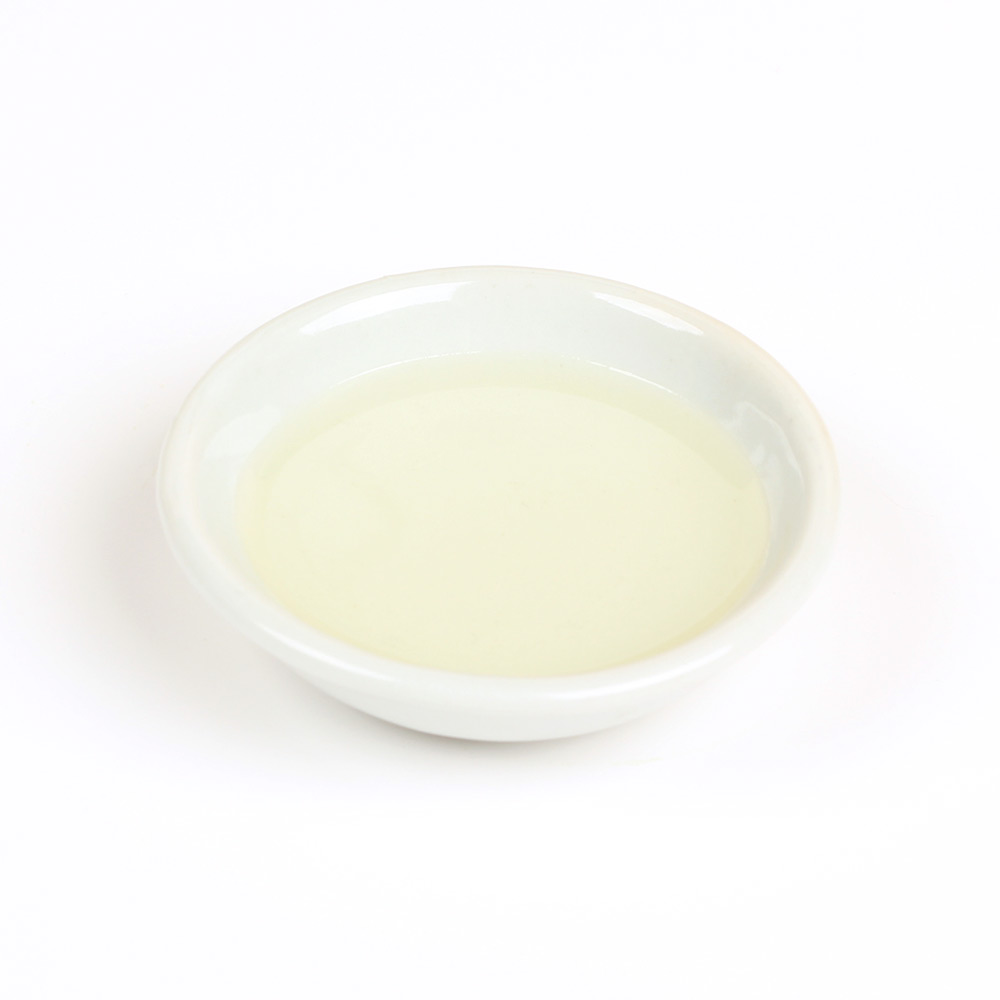
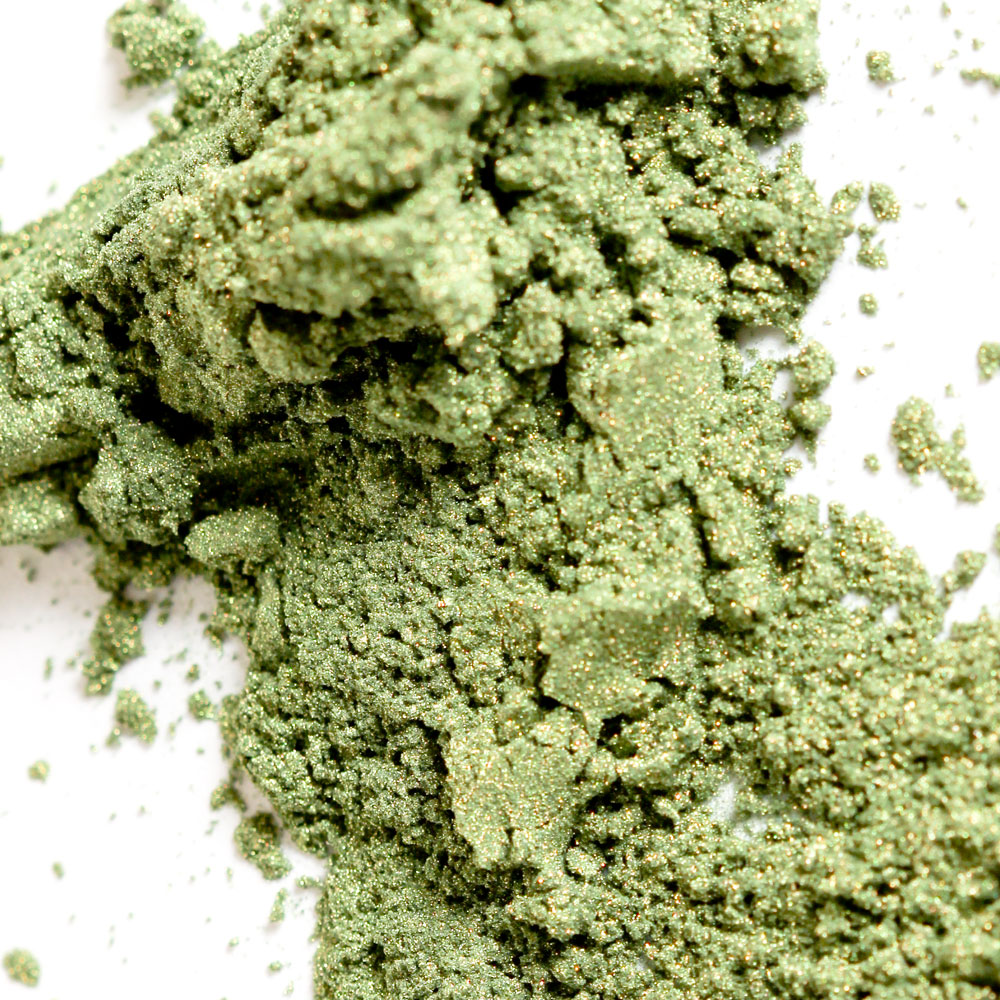

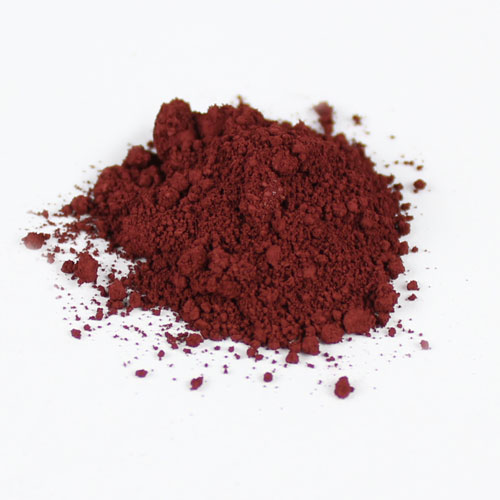
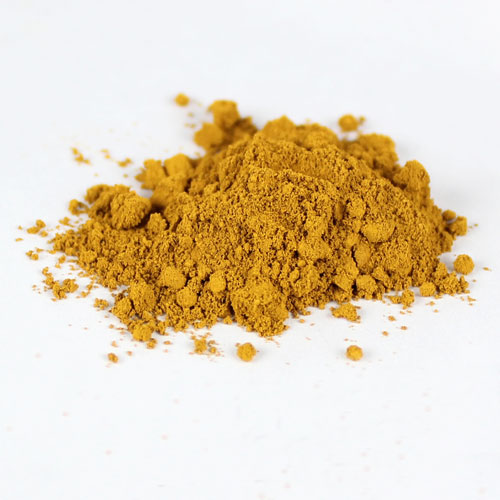

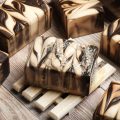

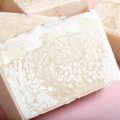
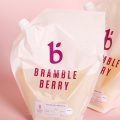
What about Labcolors? Could I use them instead? Do they work well in cold process?
You can use LabColors if you like! Keep in mind they do bleed in cold process soap, so that will affect this design. It will have more of an ombre look instead of crisp layers. 🙂
Find LabColors for cold process soap here: https://www.brambleberry.com/LabColors-for-Cold-Process-C638.aspx
This post has more on how to use them: http://www.soapqueen.com/bath-and-body-tutorials/tips-and-tricks/diluting-bramble-berry-labcolors/
-Kelsey with Bramble Berry
Thank you for the info. I did this recipe and used some bright micas and it has turned out beautifully. Really bright and cheerful. My first batch of color that turned out right!
That’s awesome, so glad to hear that Natalie!
-Kelsey with Bramble Berry
Rather than using titanium dioxides to color, can I just use micas? I would like to do this recipe but want to use my own colors and use mica. I’m assuming I would mix the mica with the oils as well for cold process?
You can use micas instead! We recommend preparing them the same way – mixing with oil beforehand and adding the dispersed color at trace. Some micas can morph in cold process soap, so make sure to check the descriptions before using them in this recipe. 🙂
Learn more about micas here: https://www.soapqueen.com/bath-and-body-tutorials/tips-and-tricks/sunday-night-spotlight-mica-colorants/
-Kelsey with Bramble Berry
I’m new to soap making and was wondering about measuring the oils. Can you just use one measuring cup for weighing the oils out before you melt them and just make sure you tare the scale out before each new addition?
Hi Lisa! Just to clarify, are you wanting to use the measuring cup to pour oils into the bowl on the scale? Or measure the oils right into the cup, then pour into your bowl? Or use cup measurements? Let me know and I can offer some tips. 🙂
-Kelsey with Bramble Berry
When you go to measure out your oils before you melt them. Do I have to measure each oil in a separate container or can I just use one measuring cup and add each oil to it that way I only have one measuring cup that I’m melting the oil in.
Thanks so much for clearing that up! You can use just one measuring cup. We do that all the time so we don’t have as many dishes! Just pour one oil in, zero the scale and pour your next one in. Then, melt them all together. 🙂
-Kelsey with Bramble Berry
I’m going to be resizing this recipe to fit the 4″ mold. My question is when determining the fragrance strength using the “fragrance calculator”, by what total do we go by? I usually add everything that in oz’s such as oil, lye & water plus the fragrance. So my question is, do I include the fragrance oz in this total when using the calculator? Or do I just include the oil, water & lye? Thanks in advance 🙂
Hi Nitza!
For the Fragrance Calculator, you’ll want to plug in the total weight of the soap – that includes oils, water and lye. You don’t need to add that fragrance weight to your mold calculations unless it’s a fairly big batch. It’s usually only about 1 ounce or so of extra weight for smaller batches. 🙂
-Kelsey with Bramble Berry
Thanks Kelsey. I can’t wait to make it. I already received the FO and its wonderful. I do have another question. I want to make it with other BB colors. In the BB website it shows how the color will look like in CP. Then it tells you how much colorant to use to achieve the color on the sample soap. My question is, if it says let’s say 1 tsp to achieve that color, is that 1 tsp after its been dispersed in oil therefore one tsp of colored oil or 1 tsp of pure color?
Those amounts are dispersed colorants! So, if it says 1 teaspoon, that’s 1 teaspoon of the color mixed into a lightweight oil. We find that helps the colors mix in nicely and prevents clumping. 🙂
-Kelsey with Bramble Berry
That’s kind of what I thought. So then just to make sure… if it says 1 tsp of colorant it means… take 1 tsp of colorant mix with 1 tbsp of oil. Then use 1 tsp of the colored oil. Thanks for your patience 🙂
Exactly! Mix the 1 teaspoon of color with 1 tablespoon of oil, then add 1 dispersed teaspoon of the oil and color mix. 🙂
-Kelsey with Bramble Berry
Hello!
I’m sorry that my question isn’t related to this tutorial, but I couldn’t post it under the “Soap behaves badly” post.
I made a soap today that riced and I don’t really know what to do about it. I really love the scent and don’t want to stop using it. It’s lavender EO, white grapefruit EO and ylang ylang EO.
Please help! I’m really disappointed about this results.
Hi Andrea!
I’m sorry about that! Ylang ylang III essential oil can accelerate in cold process soap, but it doesn’t rice so I’m not sure why that happened. What temperatures were your oil and lye? What percentage of oils are you using in your recipe? Did it start to rice as soon as the lye was added? Let me know and I’ll help you troubleshoot. 🙂
-Kelsey with Bramble Berry
I’m newer to soap making and love the goats milk soaps but the recipes are few and far between. since I own a small dairy goat farm I’d love to use my milk as much as possible. I was wondering if you can switch water for goats milk in all cold process soaps? I know the colors would be effected but would it work? thank you!
Hi Danielle!
Absolutely! You can replace water with goat milk for almost all of our cold process recipes. You can use 100% milk for the liquid, or a combination of milk and distilled water. 🙂
We do recommend freezing the milk before adding the lye to prevent scorching! Read more about working with milk here: http://www.soapqueen.com/bath-and-body-tutorials/tips-and-tricks/how-to-add-lye-to-milk-for-cold-process-soap/
-Kelsey with Bramble Berry
I love the spoon plop because of its unique patterns AND because it is easy and a great method to switch to if you batter becomes too thick unexpectedly. I planned to do the white, yellow and blue hanger swirl this evening that was shown on video, but I wanted to try a new fragrance I’ve not worked with. I think I will combine the tutorials, use the yellow, white and blue colors and the spoon plop with the new scent. I was just going to try the hanger swirl without scent. Thanks again for the idea! I’ll tell you how it went and post the videos later.
Oh that sounds like an awesome combination! I love this technique as well. I like to do it if my soap traces too quickly! 🙂
-Kelsey with Bramble Berry
where is the tutorial for the soap?
Hi Kathy! The steps for this tutorial are listed above! It’s really fun to make. 🙂
-Kelsey with Bramble Berry
It took me a little while to find also. You have to tap the little blue ” more” at the end of the summary.
Thanks for the tip Shelly! You can also click on the title of the soap too. That’s a link that takes you to the tutorial. 🙂
-Kelsey with Bramble Berry